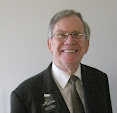On Tuesday I received a phone call from Utah. It was our trainer for the North American part of World Wide Support. She explained that she was unable to attend our Wednesday online training meeting, and asked whether I would be comfortable doing training on using the free Personal Ancestral File software to create books. I told her that I had given a lesson on that topic at our Family History Center a few months ago, and I was confident that I could do it. I asked how much time I would have, and she said to plan on 45 minutes. She suggested that I also include PAF's Advanced Focus Filter, and we discussed other things I might include. I mentioned that I had had a lot of trouble with my internet access on Monday, and this would be disastrous during an online meeting. I said I would plan to do the training from my son's house, where there was stable high-speed internet access. She agreed that it seemed like a good plan.
I contacted my son, and arranged to be there before he left for work, so we could get my laptop connected to his internet before he had to leave.
The session seemed to go well. I actually had 60 minutes, but there was no shortage of things I could have covered. My notes for the session follow:
~~~~~~~~~~~~~~~~~~~~~~~~~~~~~~~~~~~~~~~~~~~~~~~~~~~~
Some Things You Can Do With PAF
Creating Books and Charts
(click on the printer icon to access these choices)
Books:
Ahnentafel (Ancestry)
Modified Register (Descendancy)
These two books are similar, except that one traces the ancestors back in time and the other traces the descendants forward, generation by generation. They are in the form of a narrative rather than a chart. e.g. “Leah Hock was born about 1695 in of Froxfield, Hampshire, England” You can choose whether to include notes, sources, photos, etc.
Descendancy Chart
Just before Christmas each year I create a descendancy chart of about 10,000 descendants of two of my ancestors, and post this book on my web site for my cousins. A descendancy chart has the advantage of putting the maximum number of people and family relationships on a minimum of paper. Its disadvantage is that it can be hard to follow. An index is really needed. (I normally use PAF Companion for this particular book, as PAF Companion numbers the children and starts each page with a miniature pedigree.)
Cascading Family Group Records
These can form a “book”, but be sure to include the Cascading Pedigree Charts that go with them. The Pedigree Charts are a necessary road map.
Lists
PAF has a large number of built-in lists that can be viewed or printed. Some (like Possible Problems) allow you to set the parameters.
Output Options
Preview: Always click on Preview to verify the output before printing the book. It saves on cheap paper and expensive ink!
Print to File: This will send the output to an RTF word processor and open it instead of going to a printer.
NOTE: The appearance of RTF data depends upon the word processor. The pedigree chart that looks so beautiful in Word will be gibberish in WordPad. So, if it looks good in Word, save it as a Word file! The index needs to be generated in the word processor.
Print to a PDF writer: This is not a built-in feature of PAF. You need to install one of the free PDF Writers such as PrimoPDF or PDF Creator and choose it as the “Default Printer”. This automatically creates an index if one is requested. (Make sure that Print to File is not selected.)
Print to Printer: Select your printer as the Default Printer. (De-select Print to File.)
Create a Webpage: This creates a folder of linked HTML documents, that can be copied to a web host or dropbox Public folder for public viewing, or to your tablet or other mobile device.
The Amazing Advanced Focus Filter and Custom Reports
If you want to find everyone in your database who was born, married or died in Neepawa, Manitoba, it only takes 2 minutes. In the Search menu > Advanced Focus Filter > Define (select the criteria in the left-hand column and move it to the right-hand column, and you would normally select "And" to separate the criteria). Generating a custom report only takes an additional 5 minutes, once the individuals are selected. Landscape layout works best. Select the items you want included in the report, and select the sort order. Besides the usual output options, the custom report can be saved as a CSV file that can be opened as a spreadsheet.
~~~~~~~~~~~~~~~~~~~~~~~~~~~~~~~~~~~~~~~~~~~~~~~~~~~~
The PAF genealogy database software (for Windows) is still free at https://familysearch.org/products


